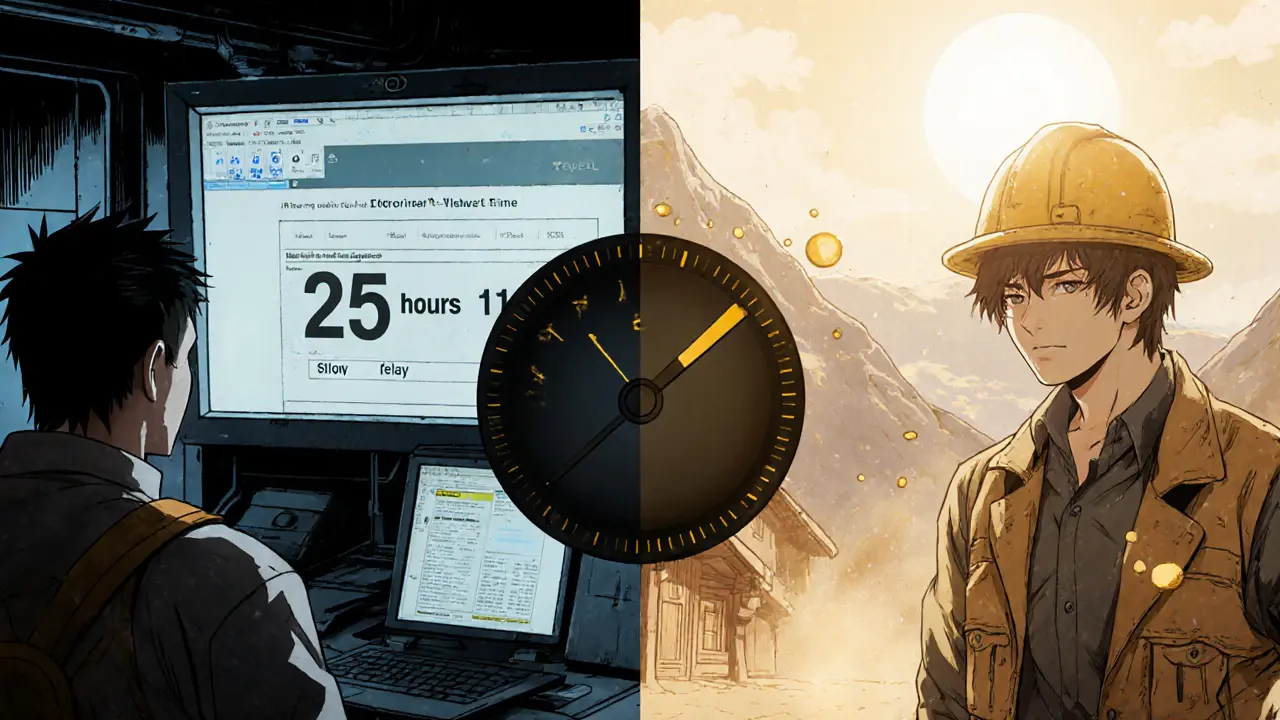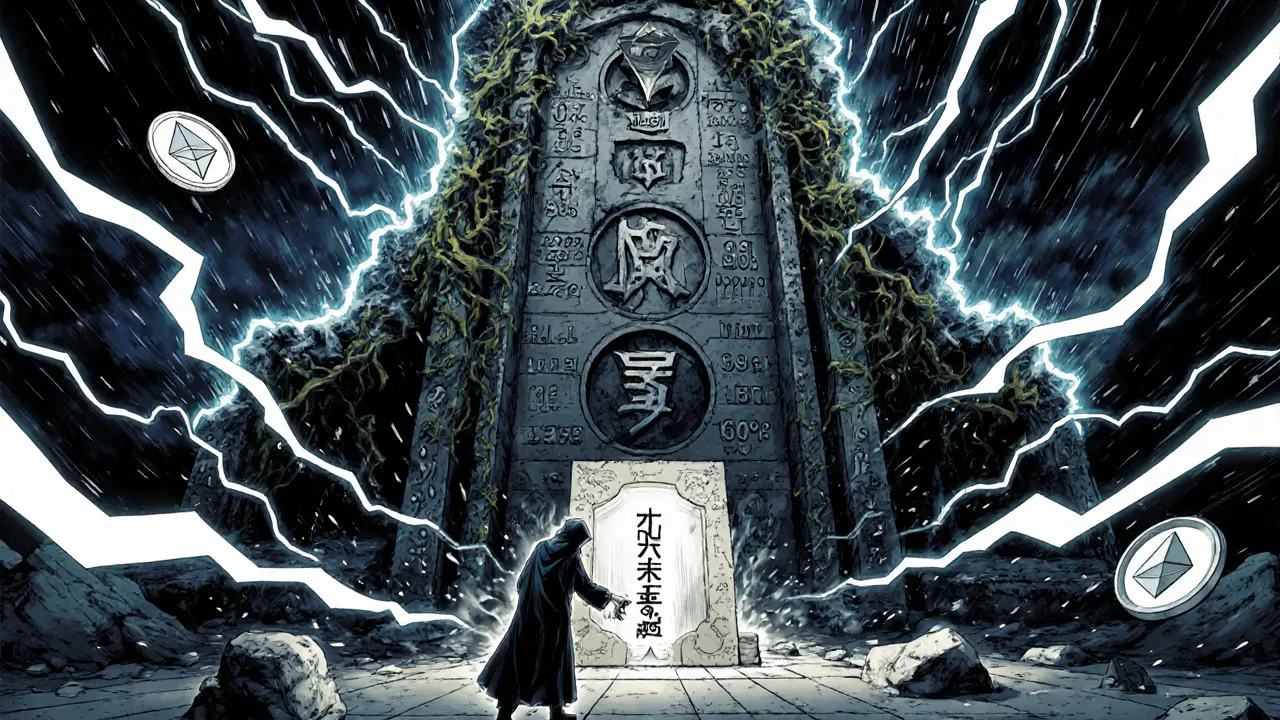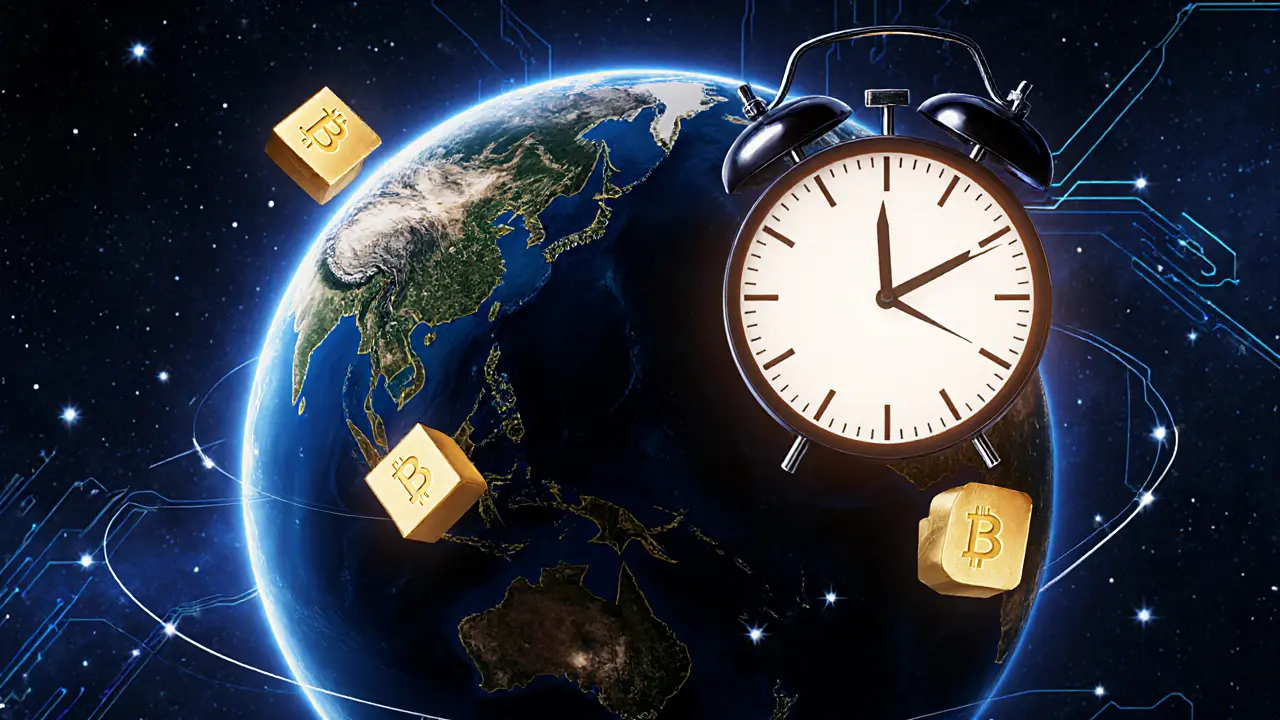Bitcoin Block Time Calculator
See how different block times affect orphan rates and network security
Results
The calculator uses the formula:Orphan Rate = (Latency / Block Time) × 100
For Bitcoin's current parameters:(500ms / 600s) × 100 = 0.083%
This explains why Bitcoin maintains a 0.1-0.5% orphan rate while Ethereum has 3-5% with 12-second blocks.
Ever wonder why Bitcoin takes about 10 minutes to confirm a block? It’s not random. It’s not arbitrary. It’s the result of a deliberate, math-driven choice made in 2008 by someone who understood network delays, security, and human behavior better than almost anyone else at the time. And that 10-minute window is still working perfectly today - 16 years later.
The 10-Minute Rule Isn’t a Timer, It’s a Balance
Bitcoin doesn’t have a clock that ticks exactly every 10 minutes. That’s a common misunderstanding. Instead, it’s an average. Sometimes blocks come in 2 minutes apart. Other times, it takes 30 minutes. There’s even a recorded gap of over 25 hours. But over time, the system pulls that average back to 10 minutes - every single time. This isn’t magic. It’s math. Bitcoin uses a difficulty adjustment that runs every 2,016 blocks - roughly every two weeks. If blocks are being found too fast, the puzzle gets harder. If they’re too slow, it gets easier. The goal? Keep the average at 10 minutes, no matter how many miners join the network or how powerful their hardware becomes. Why 10 minutes and not 5? Or 20? Because Satoshi Nakamoto was thinking about something most people ignore: network propagation.Why Not Faster? Latency Was the Real Bottleneck
Back in 2008, internet speeds weren’t what they are today. A typical connection between a miner in Berlin and one in Tokyo might have had a delay of 200 to 500 milliseconds. Even a 1-minute block time would’ve caused too many collisions - two miners finding a block at nearly the same time, but one doesn’t reach the other in time. When that happens, you get orphaned blocks. One block gets discarded. The miner who found it loses their reward. And the network wastes time resolving the conflict. A 10-minute window gave enough time for a newly found block to spread across the globe before the next one was even close to being solved. That kept orphan rates low - around 0.1% to 0.5%. Compare that to Ethereum, which has a 12-second block time and sees orphan rates of 3% to 5%. More orphaned blocks mean less security. Less security means more risk of chain reorganizations - where a transaction gets reversed after being confirmed. Bitcoin’s 10-minute target keeps that risk tiny. After just two confirmations (about 20 minutes), the chance of a transaction being reversed drops below 1%. That’s why exchanges wait for 3 to 6 confirmations before crediting large deposits - it’s not about waiting for speed. It’s about waiting for certainty.The Statistical Trick: Why Your Wait Feels Longer Than 10 Minutes
Here’s something counterintuitive: if you walk into a Bitcoin transaction at a random moment, your average wait time for the next block isn’t 5 minutes. It’s 10 minutes. Why? Because of how random events work. Imagine you’re waiting for buses that come every 10 minutes on average. But sometimes they come every 2 minutes, sometimes every 20. If you show up at a random time, you’re way more likely to land in a 20-minute gap than a 2-minute one. That’s just how probability works. The same applies to Bitcoin. Long gaps are rare, but they last longer. So statistically, you’re more likely to arrive during one of those long waits. That’s why you sometimes feel like Bitcoin is slow - because you’re more likely to experience the slow moments.
Bitcoin vs. Other Chains: Speed vs. Security
Other blockchains chose different paths. Litecoin, for example, uses a 2.5-minute block time. That’s faster, but it also means more orphaned blocks and slightly less security. Ethereum, before its shift to proof-of-stake, had a 12-19 second block time. That’s great for apps and DeFi, but it’s not ideal for a global settlement layer. Bitcoin’s design isn’t meant to compete with Ethereum on speed. It’s meant to compete with gold on trust. And for that, it needs to be slow enough to be secure. The 10-minute block time, combined with the 1 MB (later expanded to ~4 MB with SegWit) block size limit, caps Bitcoin’s transaction throughput at about 7 transactions per second. That’s not enough for everyday payments. But that’s not the point. Bitcoin’s role isn’t to replace Visa. It’s to be a tamper-proof, decentralized, global reserve asset. That’s why Layer 2 solutions like the Lightning Network exist. They handle the fast, small payments. Bitcoin’s base layer handles the big, infrequent, high-value settlements. And the 10-minute block time keeps that base layer rock-solid.Why No One Has Changed It - Even Though They Could
You might think: “Why hasn’t Bitcoin upgraded this? It’s outdated.” Because changing the block time isn’t a simple software update. It’s a hard fork. It requires every node on the network to agree. And Bitcoin’s community has spent 16 years proving that consensus is harder than code. In 2022, Bitcoin Core developer Pieter Wuille said it plainly: changing the block time would need near-unanimous agreement. That’s not happening. Why? Because the 10-minute block time is part of Bitcoin’s identity. It’s not a bug. It’s a feature. MIT researchers ran simulations in 2023. Reducing the block time to 2 minutes would increase orphan rates to 8.7% and reduce the network’s effective security by over 12%. That’s not worth the speed gain. And let’s not forget: the 10-minute block time is tied to Bitcoin’s monetary policy. Every 210,000 blocks - about every four years - the block reward halves. That’s 210,000 × 10 minutes = 2,100,000 minutes = 4 years. That schedule is baked into Bitcoin’s economic model. Change the block time, and you break the halving cycle.
What This Means for You
If you’re sending Bitcoin: don’t panic if it takes 15 minutes to confirm. That’s normal. If you’re paying for coffee, use Lightning. If you’re moving $5,000 or $50,000, wait for 3-6 confirmations. That’s the Bitcoin way. If you’re mining: your hardware doesn’t matter as much as you think. The network adjusts difficulty to keep the 10-minute average. More hash power? The puzzle just gets harder. You’re not racing others - you’re racing the algorithm. If you’re holding Bitcoin: the 10-minute block time is why your investment is secure. It’s why no single entity can rewrite history. It’s why, even after 16 years, 10 minutes still works.Final Thought: The Best Design Is the One That Doesn’t Need to Change
Bitcoin’s 10-minute block time isn’t a limitation. It’s a triumph. It’s the reason Bitcoin still exists while hundreds of other blockchains have faded. It’s simple. It’s predictable. It’s secure. And it’s been working perfectly since day one. You don’t need to fix what isn’t broken. Bitcoin doesn’t need to be faster. It just needs to be trusted. And for that, 10 minutes is still perfect.Why is Bitcoin’s block time exactly 10 minutes?
It’s not exact - it’s an average. Satoshi Nakamoto chose 10 minutes as a balance between network propagation speed and security. In 2008, with internet latency around 200-500ms, shorter blocks would’ve caused too many orphaned blocks. Longer blocks would’ve made confirmations too slow. Ten minutes gave enough time for blocks to spread globally while keeping transaction finality reasonable.
Can Bitcoin’s block time be changed?
Technically yes, but practically no. Changing it would require a hard fork - meaning every node on the network must upgrade. Bitcoin’s community values stability over speed. No major upgrade has ever changed the block time, and there’s little appetite to do so. Even MIT research shows reducing it to 2 minutes would hurt security.
Why do some transactions take longer than 10 minutes to confirm?
Because block times are random. The 10-minute figure is an average. Blocks can come every 2 minutes or take over an hour. If your transaction has a low fee, miners may prioritize others with higher fees. During high congestion, it can take 30-60 minutes for a low-fee transaction to be included - not because the block time changed, but because your transaction is waiting in line.
Does a longer block time make Bitcoin more secure?
Yes, indirectly. Longer block times reduce orphan rates, which means fewer competing chains. Fewer orphaned blocks make it harder for attackers to reverse transactions. Bitcoin’s 0.1-0.5% orphan rate is among the lowest in major blockchains. That’s why six confirmations (about 60 minutes) are considered final - it’s statistically near-impossible to rewrite history after that point.
How does the difficulty adjustment work?
Every 2,016 blocks (about every 14 days), Bitcoin checks how long it took to mine those blocks. If it took less than 20,160 minutes (10 minutes × 2,016), the difficulty increases. If it took longer, difficulty decreases. The formula is: new difficulty = old difficulty × (actual time / 20,160 minutes). This keeps the 10-minute average stable, no matter how many miners join or leave the network.
Why doesn’t Bitcoin just increase block size to handle more transactions?
Increasing block size would speed up transactions, but it also increases the risk of centralization. Larger blocks take longer to propagate, which favors big miners with better infrastructure. Bitcoin’s design avoids that. Instead of bloating the base layer, it uses Layer 2 networks like Lightning for fast, cheap payments - keeping the main chain small, secure, and decentralized.
Is the 10-minute block time a reason Bitcoin isn’t used for payments?
Yes - but that’s intentional. Bitcoin was never meant to be a daily payment system like PayPal or Visa. Its 10-minute block time and limited throughput make it ideal for large, infrequent settlements - like storing value or transferring wealth across borders. For everyday payments, users turn to Lightning Network, which handles thousands of transactions per second off-chain.
How does the block time affect Bitcoin’s price?
It doesn’t directly. But it reinforces Bitcoin’s scarcity and reliability. The 10-minute block time ensures the predictable halving schedule - every 210,000 blocks - which reduces new supply. That scarcity, combined with security, is why many see Bitcoin as digital gold. The block time helps maintain that narrative by ensuring the network remains stable and trustworthy over decades.


18 Responses
Man, I always thought the 10-minute thing was just a guess. Turns out it’s smart as hell. Bitcoin’s like that one friend who takes their time but never lets you down.
Interesting how the math just works. No drama. No politics. Just pure engineering. That’s why it lasts.
Oh please. You’re romanticizing a 15-year-old protocol designed in the early internet dark ages. Anyone with a modern stack would laugh at this "balance." Ethereum’s 12-second blocks are the future - Bitcoin’s just clinging to nostalgia like a dusty VCR.
I love how this post breaks it down so clearly - it’s not about speed, it’s about soul. Bitcoin’s 10-minute rhythm is like a heartbeat: steady, reliable, and deeply human. It doesn’t rush. It doesn’t panic. It just… holds space. And that’s why, when the world burns, people still turn to it.
Other chains scream for attention. Bitcoin whispers - and somehow, everyone leans in.
It is fascinating to observe the statistical properties of block confirmation times, particularly with regard to the inspection paradox. One’s subjective perception of wait duration is indeed skewed by the probability distribution of inter-block intervals.
10 minutes? That’s weak. America could’ve built something faster. We had the tech. We had the brains. But no - we let some guy in Japan or wherever sit around and think about "latency." Pathetic.
wait… so if i show up at a random time, i’m more likely to hit a long wait? that’s wild. i always thought it was just bad luck. maybe the universe hates me.
Let’s be real - this whole 10-minute thing is just Satoshi’s way of making sure we all suffer equally. You think you’re mining? Nah. You’re just waiting. And waiting. And waiting. Meanwhile, your electricity bill grows like a weed.
What if the 10-minute block time isn’t about latency at all? What if it’s a backdoor? Every 210,000 blocks… a signal. A countdown. A reset. The halving isn’t economic - it’s psychological. They want us to believe in scarcity… so we don’t look too closely at who’s really controlling the nodes.
Of course India has the fastest internet now. Why are we still using a 2008 design? You people are clinging to relics while we’re building quantum blockchains. Just sayin’.
This made me feel so calm. Like, I used to stress when my tx took 20 minutes - now I just breathe. It’s not slow. It’s sacred. Thank you for writing this.
Everyone who praises this "balance" is just too lazy to upgrade. You want security? Use a bank. Bitcoin’s just a glorified spreadsheet with a cult. The 10-minute wait is a feature of incompetence, not genius.
Lightning Network is the real answer. Bitcoin layer 1 is for billionaires and hoarders.
It is noteworthy that the difficulty adjustment algorithm operates with mathematical precision, ensuring temporal equilibrium despite exogenous fluctuations in computational power. This constitutes an elegant solution to the Byzantine Generals Problem under distributed consensus.
Bro, this is why I love Bitcoin. It’s like a grand old tree - doesn’t need to grow taller to be strong. The roots go deep. The branches don’t shake. Even when the wind howls, it just… stands. And yeah, it takes 10 minutes for a leaf to fall - but when it does, it lands perfectly.
I’ve seen so many shiny new chains come and go. Bitcoin? Still here. Still quiet. Still unstoppable. That’s the real magic.
So… we’re still doing this? Like, in 2025? I just wanna send a buck to my buddy for coffee. Why am I waiting 15 minutes? This is the dumbest thing I’ve ever read.
heyy i was mining last week and my block took 47 mins, i was like oh no but then it got accepted and i got paid. so yeah its random but it works. also segwit is lit lol
China and Russia are building next-gen chains with 1-second blocks. Bitcoin is a relic. The future doesn’t wait 10 minutes for anything. We’re not living in 2008 anymore.